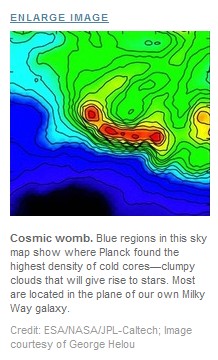| News & Events |
| Location:Home > News & Events > Science and Technology News |
| Satellite Spies Stellar Hatcheries |
SEATTLE, WASHINGTON—Studying newborns and toddlers reveals a lot about the first stages of human life, but to learn about conception and birth, you need to focus on a mother's womb. The same is true for stars. Astronomers know a lot about the first stages of a star's life, but its conception and birth are still shrouded in mystery. Quite literally, actually: Stars are born in the cores of dark, dense, cold clouds of dust. Now, the European Planck satellite has revealed more than 10,000 of these extremely cold stellar wombs. Surprisingly, many of them turn out to be larger than astronomers had expected. "It's hard to understand how such large concentrations of gas can stay this cold," says Planck team member and astrophysicist George Helou, director of the Infrared Processing and Analysis Center at the California Institute of Technology in Pasadena. The Cold Core Catalogue of Planck Objects was presented here today at the 217th meeting of the American Astronomical Society as part of the release of the first scientific results from the Planck mission. Other Planck results released today are related to remote galaxy clusters, dusty galaxies in which large numbers of new stars are born, and extremely rapidly spinning dust particles in our own Milky Way. Planck was launched in May 2009. The mission's ultimate goal is to learn more about the evolution of the universe by mapping the cosmic background radiation—the faint afterglow of the big bang. That could take another year or two, says Charles Lawrence of NASA's Jet Propulsion Laboratory, one of Planck's project scientists. Meanwhile, Lawrence says, the space observatory is revealing a lot about "everything else in the universe." The stellar wombs are a case in point. "These are the coldest objects known in the universe," says Lawrence; some are just 7° above absolute zero. Such cold objects give off faint radiation at wavelengths shorter than 1 millimeter, and Planck's sensitive detectors are great at finding them, says Helou. Using the sharper view of another European space observatory called Herschel, astronomers have studied 10 of the cold cores discovered by Planck in more detail. They turn out to be elongated and grouped into filaments. Moreover, they show a wide variety of shapes, sizes, and substructure. Some of these smaller clumps are no larger than 1 light-year across—about the size of the giant cloud of comets surrounding our own solar system. Helou is confident that the Planck observations will eventually lead to "a much better understanding of the critical last steps leading up to stellar birth." Specifically, astronomers want to know how and how fast a collapsing cloud of gas fragments into different stars. There's a lot of follow-up work to be done, however. The Planck team believes the large variety of cold cores corresponds to different stages in the prenatal evolution of stars, from cold, starless clumps to young protostellar objects still embedded in their surrounding cloud. Says Helou: "We have to place these objects in the right sequence." |
| Appendix Download |
|
|
